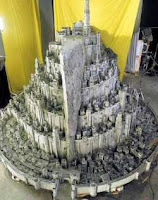'Nothing makes a model look less convincing then too much detail on distant objects.'
Monday, 1 December 2008
Forced Perspective Models
'Nothing makes a model look less convincing then too much detail on distant objects.'
Importance of Painting
Painting a model miniature adds the finishing touches to it and is very important in making the model appear realistic and giving it character. The model has to be painted to represent the materials it would be constructed from in reality. So if the model is made from plaster different elements of it may have to be painted to look like wood or metal for example to make the building look authentic.
Ageing and weathering is also a vital part of creating an authentic looking model, as everything, especially buildings are affected by the elements of rain, wind, sun etc.
Constructing Models for Destruction
If a model is going to be blown up on film then there has to already be some sort of interior constructed as part of the model to make it look convincing. Matthew Graztner (Partner to one of Hollywood's top model making companies) explains how this is done...
'We often build one layer of rooms around the inside...and fill them with miniature furniture, fittings...Then at the edge of the floors and ceilings, we fit twisted miniature I-beams, joists, air-conditioning ducts...as if the front of the building had been blown off and all this stuff has been left exposed. Once this pre-destroyed interior has been arranged and filled with dust and debris, we carefully place the facade of the building over the front and prepare it for destruction with compressed air or miniature pyrotechnics.'
Picture below, model used in X Files: The Movie (1998) Miniature was made pre-destroyed.
Materials
Destructive Plaster: This is plaster mixed with baking soda, sawdust or any other material that will keep the plaster light and make it crumbly when set.
Making Miniature Buildings
- Construct the model in sections. This helps with easier transportation of the model, which in industry will normally need to be taken to be assembled in a studio for filming.
- Identify replicated patterns and features. This can be things like repeated brickwork or facades. An original master can be created and a mould can be made from it. Then you can cast the required amount needed for the building out of which ever material is suited to the building's design and the model's function, which in many cases will have to be blown up or destroyed!
Thursday, 6 November 2008
Sugar Glass Recipe
3 cups of sugar one cup of white Karo syrup (refined molasses)
2 cups of water 1/4 (quarter) teaspoon of cream of tartar.
Mix well and heat to 300 degrees Fahrenheit. Pour into a well greased, slightly chilled mould. The finished product will become sticky to touch unless it is kept cool.
Only has a limited time of use before it starts warping.
Wednesday, 29 October 2008
Tricks of the Trade
Lots of dust and debris needs to be provided at the source of the explosion. One method is the use of cement dust which can be blown out using compressed air.
'Bigatures'

Sunday, 19 October 2008
Filming Miniature Models
- Depth of field: To make miniatures look realistic it is important to photograph them with the same depth of field as would be used in normal scale photography. This will usually involve having to get quite close to the model, but making sure that both the model and the background are in focus. For example if you filmed a normal sized car from a length of 3 metres, the car and the majority of the background would be in focus. To re-crete this depth of field on a 1:10 scale model car you would need to film the model nine tenths closer, so only 30cm away.
A couple of months ago I came across a process called Tilt-Shift photography, which is a perfect example of how important depth of field can be in relation to creating the illusion of scale. The Tilt-Shift process involves manipulating photographs of life sized objects or locations to make them look as though they are miniature scale models. Click on the link below to have a look at the results and some examples of this technique. http://www.tiltshiftphotography.net/


